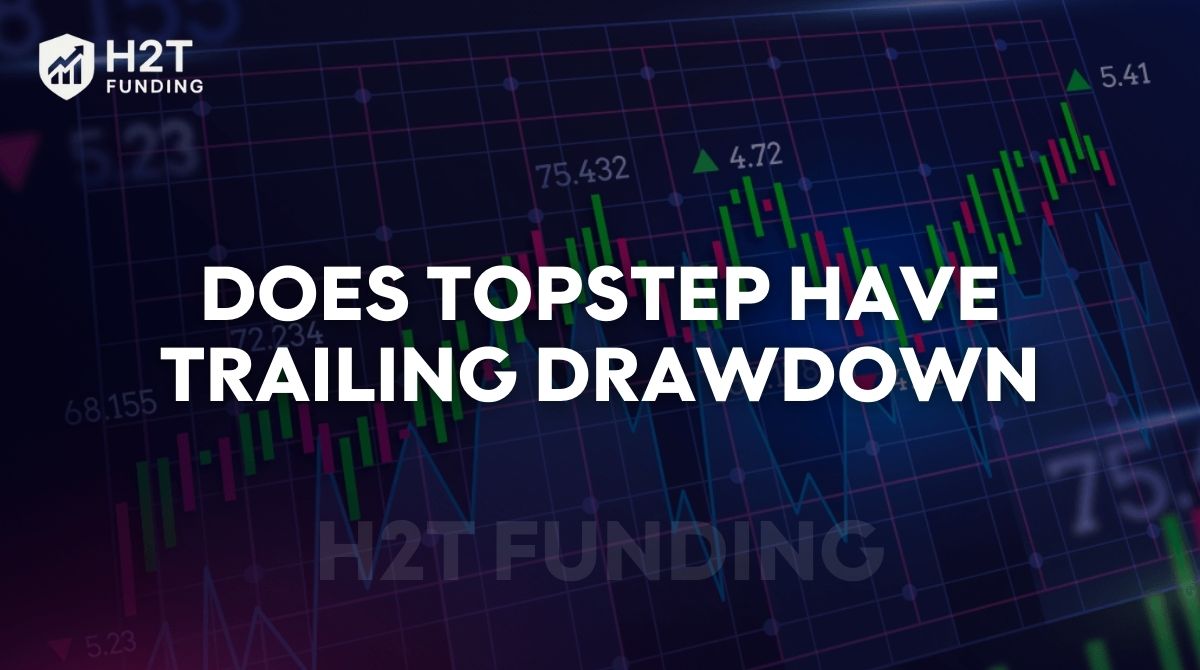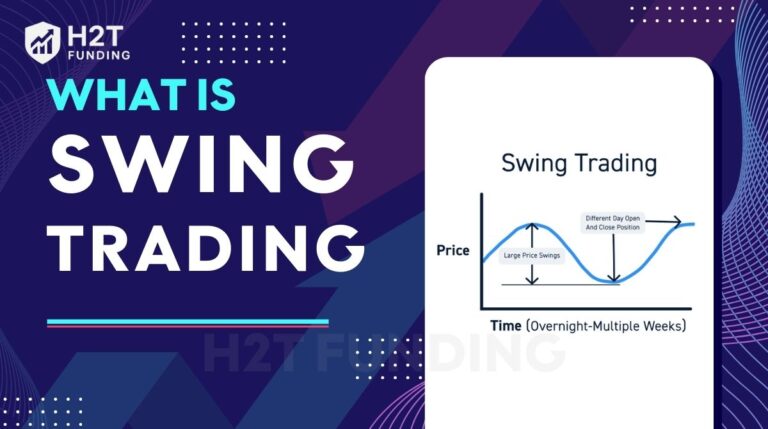For many traders, the question does Topstep have trailing drawdown? It is crucial, as this rule can be the biggest hurdle to getting funded. Even profitable traders can be disqualified, which understandably causes stress. This guide explains how Topstep’s trailing drawdown works in both the Trading Combine and Funded Accounts. H2T Funding also provides practical examples and strategies to help you manage it effectively.
If you’ve ever felt that pit in your stomach, worried about losing an account even when you’re in profit, this is for you. My goal is simple: to help you see this rule not as a trap, but as a challenge you can actually beat. Let’s get into it.
Key takeaways:
- Topstep employs a trailing drawdown: Topstep utilizes a trailing drawdown as a primary risk management tool for its trading accounts. This is also referred to as the Maximum Loss Limit.
- Different calculation methods for drawdown: The application of this rule varies depending on the trading stage, such as trading a combined and funded account.
- Trailing drawdown as a flexible limit: This loss limit increases as your account reaches new profit peaks but never decreases, effectively protecting the profits you have earned.
- Consequences of a violation: If the maximum loss limit is violated at any point during the trading day, the account will be immediately liquidated and will become ineligible for funding until it is reset.
- Risk management is crucial: To avoid violations, traders must focus on effective risk management strategies.
- Distinction from static drawdown: Unlike a static drawdown, which is a fixed limit, the trailing drawdown adjusts with account growth.
1. What is a trailing drawdown?
A trailing drawdown is a risk management tool used in trading to protect your profits while limiting losses. Unlike a fixed drawdown, which sets a static loss limit, a trailing drawdown moves up as your account balance grows but never moves down. This means that once your equity reaches a new high, the drawdown threshold adjusts upward, effectively locking in gains.
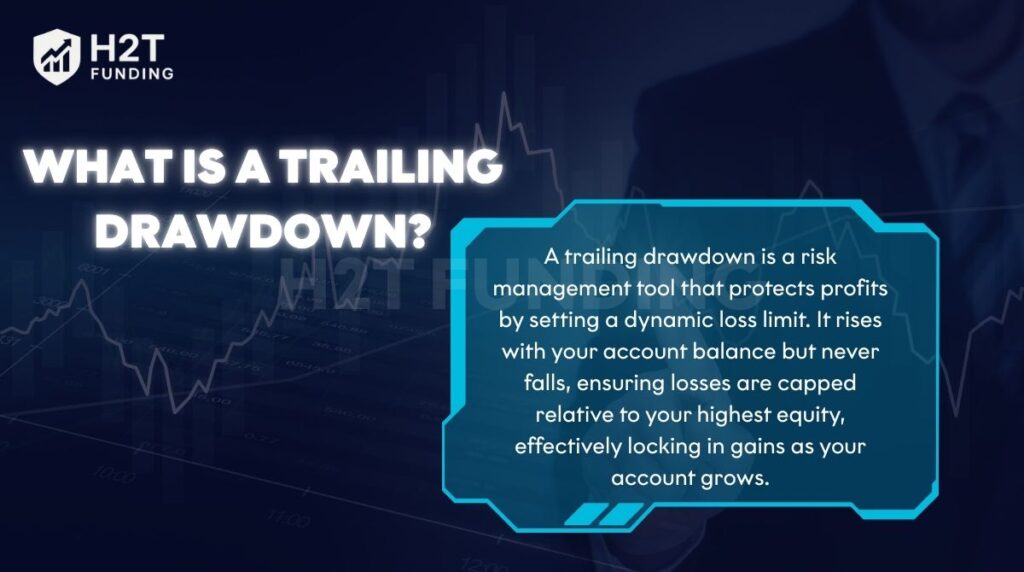
In simpler terms, if you know what is drawdown in trading is, you understand that it measures the decline from a peak in your account value. A trailing drawdown takes this concept further by trailing your profits, ensuring that your losses are always capped relative to your most recent high, rather than your starting balance. This approach encourages disciplined trading and helps prevent significant account erosion, especially during volatile market periods.
For example:
- You start with a $50,000 account and a 5% trailing drawdown ($2,500).
- At the start, the account can’t fall below $47,500.
- If the account grows to $51,000, the trailing drawdown moves up to $48,500 (51,000 – 2,500).
- If the account later drops to $48,200, the limit has been breached, which counts as a violation.
I have a video sharing about trailing drawdown, please watch it!

2. Does Topstep have trailing drawdown?
Yes, Topstep does have a trailing drawdown, which functions differently depending on your trading stage. Regarding the common question, Topstep updates the Maximum Loss Limit based on your end-of-day balance, but if your account balance falls to or below this limit during the trading session, the rule is considered broken.
Temporary intraday losses are allowed as long as your account balance does not fall to or below the Maximum Loss Limit at any point during the trading session.

Knowing what leverage in trading is also important. Higher leverage increases potential gains but also magnifies risk, making careful management of trailing drawdown essential. By focusing on consistent performance rather than reacting to every intraday fluctuation, traders can protect profits while following Topstep’s rules.
3. Topstep trailing drawdown analysis
Understanding how Topstep calculates trailing drawdown is essential for any trader preparing for the Combine or a Funded Account. The trailing drawdown acts as a dynamic risk control mechanism, protecting profits while limiting losses.
Before diving into the specifics, it’s important to understand that Topstep calculates trailing drawdown differently depending on the account stage. Whether you are in the Trading Combine, a standard funded account, or one of the express funded accounts, the underlying principle is the same: the drawdown moves up as your account makes profits, but it never moves down.
- Trading Combines: In the Trading Combines, the drawdown is calculated based on your end-of-day (EOD) balance. This is more forgiving, as it only considers realized gains (closed profits) and isn’t affected by unrealized gains during the trading day.
- Live Funded Accounts (Simulated or Live): For funded accounts, Topstep enforces the Maximum Loss Limit as part of its risk management rules. If the account balance falls to or below this limit, the account will be closed according to the applicable funded account rules.
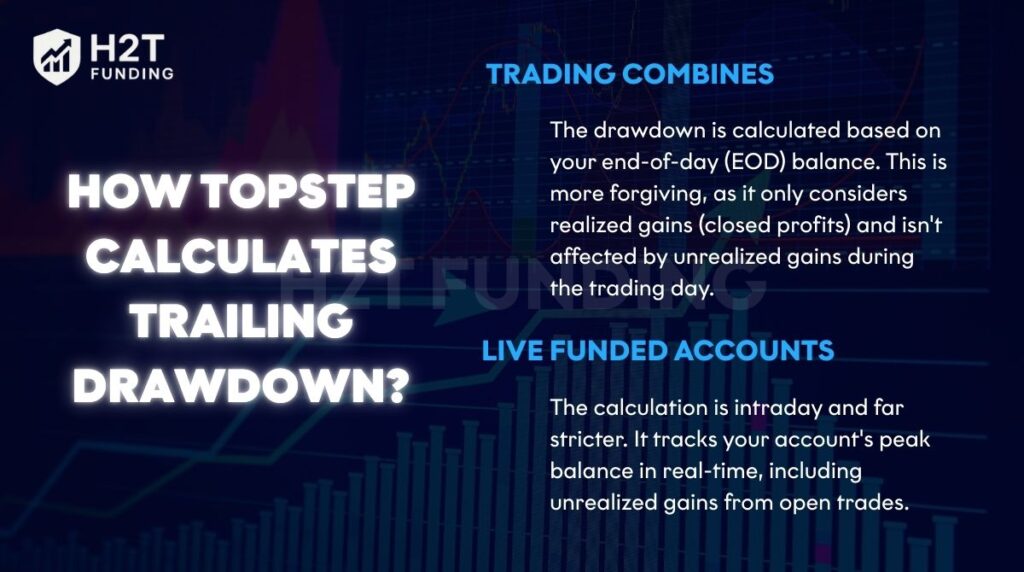
Example 1 – $50,000 trading combine account
- Starting balance: $50,000
- Trailing drawdown limit: $2,000
- Starting threshold: $48,000
| Day | End-of-Day Balance | Trailing Limit | Status |
|---|---|---|---|
| 1 | 52,500 | 50,500 | Safe |
| 2 | 50,700 | 50,500 | Safe |
| 3 | 50,400 | 50,500 | Violation → Account closed |
Example 2 – $100,000 funded account (Intraday)
- Starting balance: $100,000
- Trailing drawdown limit: $3,000
- Starting threshold: $97,000
| Event | Account Balance | Trailing Limit | Status |
|---|---|---|---|
| Intraday grows to 104,000 | 104,000 | 101,000 | Safe |
| Intraday drops to 100,400 | 100,400 | 101,000 | Violation → Account closed |
4. What happens if you violate the maximum loss limit?
Exceeding the Maximum Loss Limit is a serious event in Topstep. Even if your account has been profitable earlier, crossing this limit triggers immediate actions designed to protect the firm and enforce strict risk management. Understanding the consequences helps you trade more carefully and avoid costly mistakes.

- Automatic account liquidation: Once the Maximum Loss Limit is breached, the liquidation of your account happens automatically for the rest of the trading day. This strict risk management rule is designed to prevent further losses.
- Ineligibility for funding and payouts: After a violation, the account becomes ineligible for funding until it is reset. This means you cannot earn payouts or continue trading with live capital until you requalify.
- Loss of open positions and unrealized gains: Any open trades or unrealized profits are forfeited when the account is liquidated. This highlights why monitoring your trailing drawdown and booking profits on time is critical.
- Reset required to resume funded trading: To regain access to funded trading, you must purchase a reset or requalify in the Trading Combine. Maintaining discipline in line with the consistency rule in trading is essential before attempting to trade with live capital again.
- Opportunity to practice: Even after violating the limit, you can continue to practice trading on the same account once the markets reopen, or use a Practice Account to refine strategies without risking funding. Understanding what is consistency rule in trading is can help you stay disciplined and avoid repeated violations.
5. Compare trailing drawdown vs static drawdown
After confirming the answer to does Topstep has a trailing drawdown, many traders naturally wonder how this compares to a static drawdown. Understanding the difference is crucial for choosing the right prop firm. Both are designed to limit losses, but they operate in different ways and affect trading strategies differently. Here are some key differences between trailing drawdown vs static drawdown
| Feature | Trailing Drawdown | Static Drawdown |
|---|---|---|
| Definition | A dynamic limit that moves upward as your account balance grows. Protects profits by “trailing” the highest end-of-day balance. | A fixed loss limit that does not change, regardless of profits. The threshold stays constant from the start. |
| Adjustment | Increases only when your account hits a new high. Never decrease, even if your account loses value. | Remains the same throughout the trading period. Losses below this limit trigger a violation, even if your account has grown since the start. |
| Profit Protection | Actively protects gains because the loss limit rises with your account balance. | Offers no protection for profits beyond the initial limit. Any loss beyond the static limit counts as a violation. |
| Risk Flexibility | More flexible for traders, especially with intraday swings, as Topstep calculates trailing drawdown based on end-of-day balance. | Less flexible; static drawdown can feel strict because the limit doesn’t adapt to account growth. |
| Ideal for | Traders who want to gradually increase risk as their account grows, rewarding consistent profitability. | Traders who prefer a straightforward, unchanging limit or firms that want a simpler, more predictable risk rule. |
6. Strategies for managing trailing drawdown at Topstep
Effectively managing a trailing drawdown can be the key to passing the Combine or keeping a Funded Account safe. The following strategies not only help you stay within limits but also show how each approach protects your account and rewards disciplined trading:
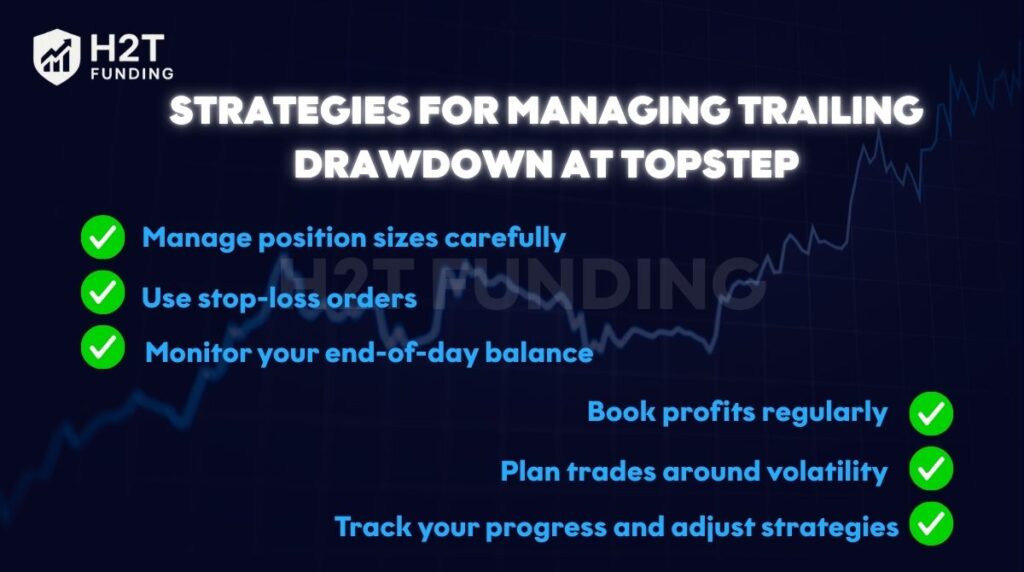
- Manage position sizes carefully: Avoid risking too much on a single trade. Smaller, controlled positions reduce the chance of large swings that could breach your drawdown limit, allowing you to maintain capital and stay in the game longer.
- Use stop-loss orders: Always define exit points for every trade. Stop losses limit potential losses and safeguard your account from unexpected market movements, helping you preserve profits while building disciplined risk management skills.
- Monitor your end-of-day balance: Keep track of your account balance at the close of each trading day, since this determines compliance with the trailing drawdown. This awareness prevents unexpected violations and lets you plan trades strategically to protect your gains.
- Book profits regularly: In the Trading Combine®, the Maximum Loss Limit is updated based on the account’s end-of-day balance, meaning only realized gains at the close contribute to raising the limit, so closing winning trades helps increase your loss limit. Regularly locking in profits gradually raises your safety net and rewards consistent, profitable trading.
- Plan trades around volatility: Avoid overleveraging during highly volatile periods. Understanding market conditions reduces the risk of sudden drops that could push you below the limit, protecting both capital and confidence while supporting steady growth. Using technical insights from how to trade using indicators, such as trend lines or momentum signals, can further guide safer entry and exit points.
- Track your progress and adjust strategies: Use your trader dashboard provided by Topstep or a personal trading journal to monitor your account balance. Comparing tools like simple moving average vs exponential moving average helps identify trends more accurately, allowing you to adjust positions and improve your trading discipline.
By integrating these strategies and understanding the benefits they offer, traders can maximize their chances of success and protect their profits. This approach allows them to trade with confidence without constantly worrying about violating the trailing drawdown rule.
7. How to avoid trailing drawdown violations at Topstep
For traders at Topstep, avoiding trailing drawdown violations is essential not only to keep the account alive but also to secure your profits for payout. Since Topstep calculates the trailing drawdown based on your end-of-day balance, careful daily management and disciplined trading are key to staying within the limit.
Key strategies to avoid violations:
- Manage risk and position sizes: Carefully control how much of your account you risk per trade. Overly large positions can create sudden losses that push your balance below the trailing drawdown limit. By keeping position sizes proportional to your account, you protect both capital and gains.
- Use stop-losses consistently: Always define exit points for trades to limit unexpected losses. Stop losses help prevent intraday swings from turning into violations, especially since the trailing drawdown only increases with realized gains, not unrealized profits.
- Book profits regularly: To raise your trailing drawdown limit, you need to close profitable trades. Realized gains move your loss threshold upward, locking in profits and giving you more room for future trades. Leaving gains unrealized during the day does not increase your limit, so timely profit-taking is essential.
- Adjust trading during volatile periods: Avoid overleveraging when markets are highly volatile. Large, sudden swings can threaten your account balance and push you below the drawdown limit. Planning trades around volatility reduces stress and preserves capital.
- Monitor balances and drawdown levels daily: Track your end-of-day account balance, realized profits, and trailing drawdown. Knowing where you stand allows you to make informed decisions, avoid unnecessary violations, and maintain a consistent growth strategy.
How trailing drawdown affects payouts:
Violating the trailing drawdown has a direct impact on your ability to withdraw profits:
- If your account closes below the trailing drawdown limit, you lose access to your current profits until you reset or requalify.
- To be eligible for payouts, your account must remain above the trailing drawdown threshold and comply with all daily and weekly loss limits.
- Properly managing trades and locking in realized gains ensures your profits are secure and can be withdrawn once Topstep approves a payout.
By combining careful risk management, disciplined trading, and regular profit booking, traders can stay within the trailing drawdown limit, protect their account, and achieve consistent payouts without unnecessary stress.
8. Notes on the trailing personal daily loss limit (TopstepX)
Topstep provides an optional risk management tool called the “Personal Daily Loss Limit.” The Trailing Personal Daily Loss Limit in TopstepX is an important tool for managing risk and protecting your account. While it helps enforce discipline and secure profits, there are several key points every trader should keep in mind to avoid surprises:
- It’s an optional tool: You can choose to enable or disable this feature. If enabled, it will automatically liquidate your open positions for the day if you hit your preset loss limit, helping you avoid breaching the more critical Maximum Loss Limit
- It only tracks realized gains and losses: The limit moves up only when trades are closed for a profit. Unrealized gains from open positions do not raise your daily loss limit, so booking profits regularly is essential.
- End-of-day calculation: TopstepX updates your trailing personal daily loss limit based on your end-of-day account balance, not intraday swings. This means temporary losses during the day won’t trigger a violation, giving you some flexibility in managing trades.
- Separate from maximum account drawdown: The daily loss limit is distinct from the overall maximum loss limit. You can hit your daily limit without violating the total drawdown, but repeated daily violations will impact your progress and funding eligibility.
- Impact on payouts: The Personal Daily Loss Limit is an optional risk-management tool and does not replace Topstep’s official payout eligibility rules. Proper planning and disciplined risk management are crucial to ensure your profits remain withdrawable.
- Plan trades with limits in mind: Always calculate the risk per trade in relation to your daily limit. This prevents overexposure and reduces the chance of sudden violations.
- Use as a guide, not a target: Avoid trading up to the maximum daily loss. Treat it as a safety net rather than a goal, and focus on steady, consistent gains.
9. Common mistakes traders make with Topstep trailing drawdown
Topstep uses a trailing drawdown, but most traders do not fail because the trailing drawdown is too strict. They fail because they misunderstand how it works and react incorrectly on a psychological level while trading.
Topstep’s trailing drawdown is designed to:
- Protect the prop firm’s capital
- Eliminate emotional, undisciplined trading behavior
Below are the three most common mistakes that cause traders to lose their accounts, even though their trading strategy is theoretically profitable.
9.1. Believing the trailing drawdown resets every day
This is the most dangerous misunderstanding for new traders at Topstep.
The core mistake: Many traders assume that the trailing drawdown:
- Resets daily like a daily loss limit
- Applies only to the current trading day
The reality: Topstep’s trailing drawdown follows the highest equity level of the account and does not reset each day. When a new equity high is made, the drawdown level is “pulled up” accordingly, but it is never loosened if losses occur afterward.
Why does this misunderstanding cause traders to fail?
- Traders make a profit on day one and assume day two comes with fresh “room” to trade
- On the following day, even a small losing streak can:
- Hit the trailing drawdown
- Result in the account being closed immediately
Traders operate as if each day is a new account, while the prop firm views the account as a continuous risk curve.
9.2. Overtrading after becoming profitable
One common paradox at Topstep is this: Traders fail most often… after winning days.
The psychological mechanism behind this mistake:
- Making profits → excessive confidence
- Believing the trailing drawdown is now far away.
This leads to:
- Taking more trades
- Lowering setup standards
- Increasing position size
Why overtrading is extremely dangerous with a trailing drawdown:
- The trailing drawdown moves up with the equity peak
- Every winning trade pulls the drawdown level higher
But with just a few consecutive losing trades:
- Equity drops rapidly
- The trailing drawdown is hit before the trader can react
Risk management perspective:
- Topstep does not punish traders for small losses.
- Topstep removes traders who do not know when to stop after winning.
Prop firms evaluate the ability to retain profits, not just the ability to generate profits.
9.3. Holding losing trades near the trailing drawdown threshold
This is an emotionally driven mistake, not a technical one.
When equity approaches the trailing drawdown level, traders often fall into two dangerous states:
- Fear of cutting losses because one stop-out kills the account.
- Hope that the market will reverse
Common behaviors:
- Moving the stop loss further away
- Refusing to accept a small losing trade
- Allowing losses to grow beyond the original plan
Why this almost always leads to failure:
- Trailing drawdown gives no room for negotiation
- Once equity touches the threshold:
- The account is closed immediately
- There is no chance to recover.
Topstep accounts usually do not die from one large losing trade, but because traders are unwilling to accept one small loss.
10. FAQs
No. Topstep doesn’t automatically place a trailing stop loss on your trades. Instead, it enforces a Trailing Drawdown, which is an account-level rule. You’re responsible for setting your own stop-loss orders to manage positions.
Yes. Every account has a maximum loss limit. This rule protects both the trader and the firm by capping losses. For example, a $100K account starts with a $3,000 cushion, which trails upward as you grow.
The biggest drawback is the trailing drawdown rule. Unlike static models, it reduces your cushion as profits grow. This can feel restrictive and make aggressive scaling harder. On the flip side, it forces traders to respect risk management.
No. The drawdown only moves upward and never resets downward. Once it rises, it stays at that level permanently.
If you close below the trailing limit, your account is terminated immediately. In the Combine, you’ll need a reset. In a funded account, you’ll lose your live account and must requalify from scratch.
It’s strict, but many traders see it as fair because it rewards consistency. Everyone follows the same rule, and it prevents reckless traders from blowing up the firm’s capital. If you’re disciplined, it won’t stop you from passing or making payouts.
It’s possible, but risky. Big position sizes may hit profit targets quickly, but they also shrink your cushion faster. The trailing drawdown punishes volatility, so slow, consistent growth is the safer path.
To clarify the Topstep weekly loss limit, it’s important to know that Topstep does not have an official one. The core rules are the Daily Loss Limit and the Topstep maximum drawdown (also known as the Trailing Max Drawdown). However, effective risk management involves setting your own weekly caps to maintain discipline.
In the combine, you must purchase a reset to continue. In a funded account, you lose access and must start the qualification process again. Many traders treat this as a chance to refine their approach before trying again.
11. Conclusion
So, does Topstep have trailing drawdown? The answer is yes. While it can be challenging, traders who apply solid risk management strategies and stay disciplined can navigate the rules successfully and protect their profits. Combining awareness of the trailing drawdown with careful position sizing, stop-losses, and daily monitoring will help you avoid violations.
If you’re looking for a different experience, you might also consider comparing Topstep with other prop firms. Some traders prefer firms with static drawdowns or even no trailing drawdown at all, which can offer more flexibility and a different approach to risk management. Understanding these differences will help you choose the trading program that best aligns with your style and goals.
For more guidance and practical strategies, check out H2T Funding under our Prop Firm & Trading Strategies category to help you manage drawdowns and maximize your chances of trading success.

